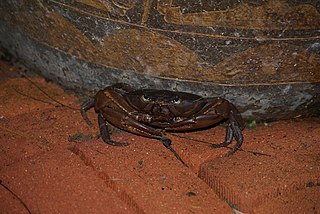
Chionoecetes is a genus of crabs that live in the northern Pacific and Atlantic Oceans.

Xanthidae is a family of crabs known as gorilla crabs, mud crabs, pebble crabs or rubble crabs. Xanthid crabs are often brightly coloured and are highly poisonous, containing toxins which are not destroyed by cooking and for which no antidote is known. The toxins are similar to the tetrodotoxin and saxitoxin produced by puffer fish, and may be produced by bacteria in the genus Vibrio living in symbiosis with the crabs, mostly V. alginolyticus and V. parahaemolyticus.

Callinectes is a genus of crabs, containing 16 extant species, including the Atlantic blue crab, C. sapidus:

Belliidae is a family of crabs of the order Decapoda.

Procambarus is a genus of crayfish in the family Cambaridae, all native to North and Central America. It includes a number of troglobitic species, and the marbled crayfish (marmorkrebs), which is parthenogenetic. Originally described as a subgenus for four species, it now contains 161 species in 16 subgenera.

Pseudothelphusidae is a family of freshwater crabs found chiefly in mountain streams in the Neotropics. They are believed to have originated in the Greater Antilles and then crossed to Central America via a Pliocene land bridge.

Macrobrachium is a genus of freshwater prawns or shrimps characterised by the extreme enlargement of the second pair of pereiopods, at least in the male.

Pugettia is a genus of kelp crabs, in the family Epialtidae. It comprises the following species:
Allacanthos is a genus of crabs in the family Pseudothelphusidae
Odontothelphusa is a genus of crabs in the family Pseudothelphusidae, containing the following species:
Potamocarcinus is a genus of crabs in the family Pseudothelphusidae.
Ptychophallus is a genus of crabs in the family Pseudothelphusidae.

Epilobocera is a genus of crabs in the family Pseudothelphusidae, containing the following species:
Phrygiopilus is a genus of crabs in the family Pseudothelphusidae, containing the following species:
Spirothelphusa is a genus of crabs in the family Pseudothelphusidae, containing the following species:
Tehuana is a genus of crabs in the family Pseudothelphusidae, containing the following species:
Villalobosius is a genus of crabs in the family Pseudothelphusidae, containing a single species, Villalobosius lopezformenti. It lives in the northern part of the state of Oaxaca, Mexico, on the Isthmus of Tehuantepec, and is adapted to a troglobitic lifestyle.
Micropanope is a genus of crabs in the family Xanthidae, containing one exclusively fossil species and the following species:

The Panopeidae are a family containing 26 genera of morphologically similar crabs, often known as "mud crabs". Their centers of diversity are the Atlantic Ocean and eastern Pacific Ocean.
Randallia is a genus of true crabs in the family Leucosiidae. There are about 17 described species in Randallia.










